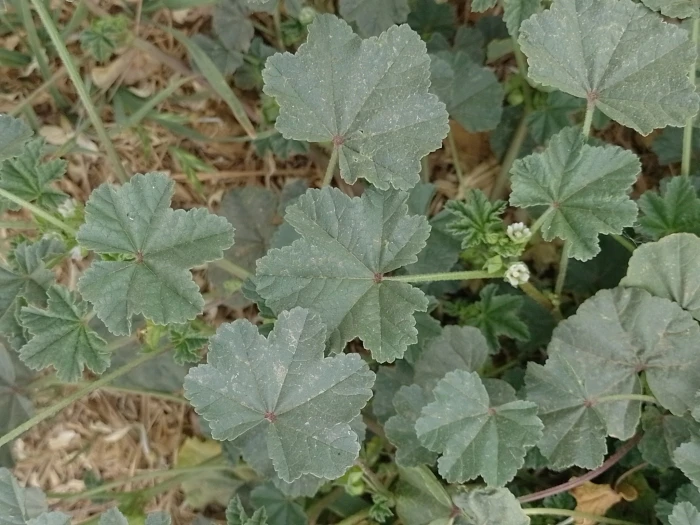Cheeseweed
(Malva parviflora)
Cheeseweed (Malva parviflora)
/
/

Tomás Carranza Perales
CC BY 4.0
Image By:
Tomás Carranza Perales
Recorded By:
Copyright:
CC BY 4.0
Copyright Notice:
Photo by: Tomás Carranza Perales | License Type: CC BY 4.0 | License URL: http://creativecommons.org/licenses/by/4.0/ | Rights Holder: Tomás Carranza Perales | Publisher: iNaturalist | Date Created: 2023-10-21T10:31:22-07:00 |
























Estimated Native Range
Climate Requirements
| • Precipitation | 15" - 18" |
| • High Temp. | 77°F - 96°F |
| • Low Temp. | 34°F - 47°F |
Summary
Malva parviflora, commonly known as cheeseweed or small-flowered mallow, is an annual or biennial herb that is native to the Mediterranean region, including Northern Africa, Europe, and Asia, and has become naturalized in many parts of the world. It typically grows up to 31 inches tall and features broad, lobed leaves and small white to pale pink flowers that bloom from spring to fall. The plant is often found in disturbed sites, agricultural land, and urban areas, where it can form dense stands.
Cheeseweed is valued for its rapid growth and adaptability to various soil types, but it is often considered a weed due to its invasive nature in some regions. It is used in some traditional medicine systems and as a foraged edible plant, with leaves that can be eaten raw or cooked. In cultivation, it prefers full sun to part shade and can tolerate a range of soil conditions, from dry to moist, but it thrives in well-drained soils. It is drought-tolerant once established and requires minimal maintenance. However, it can become problematic if not managed, as it self-seeds prolifically and can outcompete native vegetation.CC BY-SA 4.0
Cheeseweed is valued for its rapid growth and adaptability to various soil types, but it is often considered a weed due to its invasive nature in some regions. It is used in some traditional medicine systems and as a foraged edible plant, with leaves that can be eaten raw or cooked. In cultivation, it prefers full sun to part shade and can tolerate a range of soil conditions, from dry to moist, but it thrives in well-drained soils. It is drought-tolerant once established and requires minimal maintenance. However, it can become problematic if not managed, as it self-seeds prolifically and can outcompete native vegetation.CC BY-SA 4.0
Plant Description
- Plant Type: Herb
- Height: 1-3 feet
- Width: 1-2 feet
- Growth Rate: Moderate, Rapid
- Flower Color: White
- Flowering Season: Spring
- Leaf Retention: Deciduous
Growth Requirements
- Sun: Full Sun, Part Shade
- Water: Medium
- Drainage: Medium
Common Uses
Edible*Disclaimer: Easyscape's listed plant edibility is for informational use. Always verify the safety and proper identification of any plant before consumption., Low Maintenance
Natural Habitat
Native to the Mediterranean region, including Northern Africa, Europe, and Asia, and found in disturbed sites, agricultural land, and urban areas
Other Names
Common Names: Cheeseweed, Dwarf Mallow, Egyptian Mallow, Least Mallow, Small-Flowered Mallow, Mallow
Scientific Names: Malva parviflora, Althaea mareotica, Althaea microcarpa, Althaea parviflora, Malva bivoniana, Malva coronata, Malva cristata, Malva flexuosa, Malva heterocarpa
GBIF Accepted Name: Malva parviflora